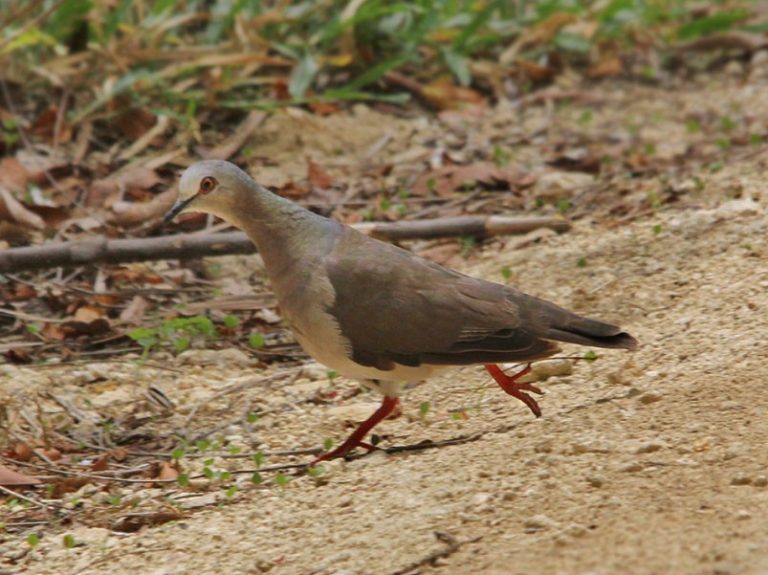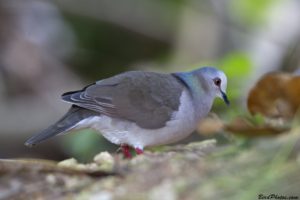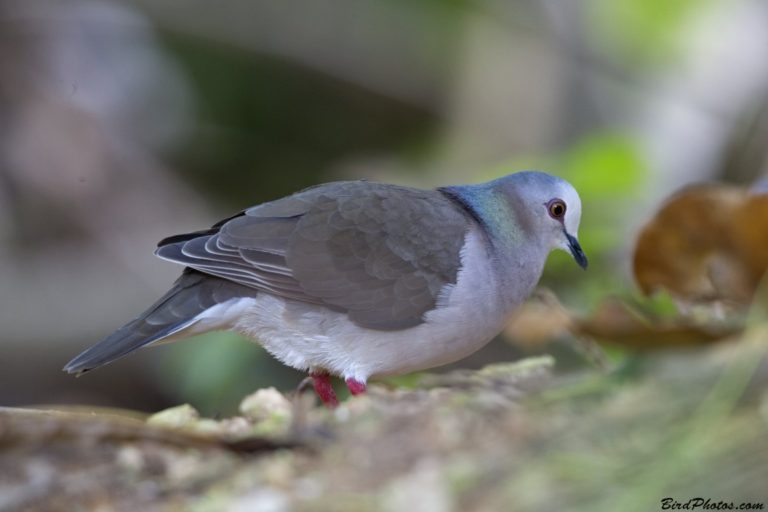Birdfinding.info ⇒ An isolated single-island endemic form of Caribbean Dove that is likely endangered in its minuscule range, as it is naturally confined to a land mass of 10 square miles. Can be found at the San Andrés Botanical Garden, Big Pond, and elsewhere that adequate habitat remains—mainly on the southern half of the island.
“San Andrés Dove”
Leptotila jamaicensis neoxena
Endemic to Isla San Andrés (Colombian possession about 170 miles east of central Nicaragua), where it occurs in remnant patches of native woodland and gardens.
Little-known and poorly documented. Not generally recognized as a distinct form—although it is it readily distinguishable from other forms of Caribbean Dove. (See Notes below.)
Identification
Typical Leptotila pattern and coloration, with notably white forecrown and faintly bluish-gray hindcrown.

“San Andrés Dove,” L. j. neoxena, showing greenish iridescence on nape. (Big Pond, Isla San Andrés; May 25, 2015.) © Adrian Braidotti

“San Andrés Dove,” L. j. neoxena, showing greenish iridescence on nape. (Big Pond, Isla San Andrés; May 25, 2015.) © Adrian Braidotti
Iridescent patch on the nape is greenish-yellow and shades to green and blue on the upper back. Unlike the other forms of Caribbean Dove, it entirely lacks red or rufous coloration on the neck.
Notes
Monotypic form, one of three potentially distinct forms of Caribbean Dove.
Frontiers of Taxonomy: Caribbean Dove.
The Caribbean Dove (Leptotila jamaicensis) includes four well differentiated subspecies that are geographically isolated and evidently diverging toward full speciation. Thus far, taxonomic authorities have not emphasized the remarkable differences among them—differences that seem facially sufficient to merit the recognition and awareness that individual common names confer.
Pending further research, I suggest provisional recognition of three distinct forms of Caribbean Dove:
“Red-necked Dove,” L. j. jamaicensis (including collaris): The two subspecies native to Jamaica and the Cayman Islands are mostly similar to one another in plumage and voice. Both have a bold white bar on the side of the chest and a contrasting reddish swath on the nape and sides of the neck that gleams with iridescence: rosy (varying from magenta to coppery) on the sides and yellow, green, and blue on the back. Both primarily sing a monotone three-note call.
“Yucatán Dove,” L. j. gaumeri: The subspecies native to the Yucatán Peninsula and Honduran Bay Islands differs from jamaicensis and collaris in its basic plumage pattern, as it has no white bar on the side of the chest and its neck is far less colorful and contrasty—it has only a slight reddish tone, but is similarly iridescent and gleams with approximately the same colors as on jamaicensis and collaris. It primarily sings a four-note call with inflected phrasing. Gaumeri is notably variable in appearance and vocalizations.
“San Andrés Dove,” L. j. neoxena: The subspecies confined to Isla San Andrés differs from the others in plumage pattern and color, as it has no white bar on the side of the chest and its neck is plain grayish-brown, with a smaller iridescent patch that is yellow, green, and blue—entirely lacking the red tones that predominate on the other forms. It primarily sings a four-note call with inflected phrasing. Neoxena appears to be little-studied, with only a handful of publicly available photographs and recordings. In light of its tiny range and shrinking habitat area, it is likely nearing extinction.

“Red-necked Dove,” L. j. jamaicensis. © Ignacio Yúfera

“Yucatán Dove,” L. j. gaumeri. © Jim Stasz

“San Andrés Dove,” L. j. neoxena. © Tom Friedel
References
Baptista, L.F., P.W. Trail, H.M. Horblit, and P. Boesman. 2018. Caribbean Dove (Leptotila jamaicensis). In Handbook of the Birds of the World Alive (J. del Hoyo, A. Elliott, J. Sargatal, D.A. Christie, and E. de Juana, eds.). Lynx Edicions, Barcelona. https://www.hbw.com/node/54236. (Accessed January 13, 2018.)
eBird. 2019. eBird: An online database of bird distribution and abundance. Cornell Lab of Ornithology, Ithaca, N.Y. http://www.ebird.org. (Accessed January 18, 2019.)
McMullan, M., and T. Donegan. 2014, Field Guide to the Birds of Colombia (Second Edition). Fundación Proaves de Colombia, Bogotá.
Gibbs, D., E. Barnes, and J. Cox. 2001. Pigeons and Doves: A Guide to the Pigeons and Doves of the World. Yale University Press, New Haven, Connecticut.
